Components Engine coolant temperature sensor 2AD-FHV
Removal Engine coolant temperature sensor 2AD-FHV
Inspection Engine coolant temperature sensor 2AD-FHV
Installation Engine coolant temperature sensor 2AD-FHV
Engine coolant temperature sensor 2AD-FHV
Components
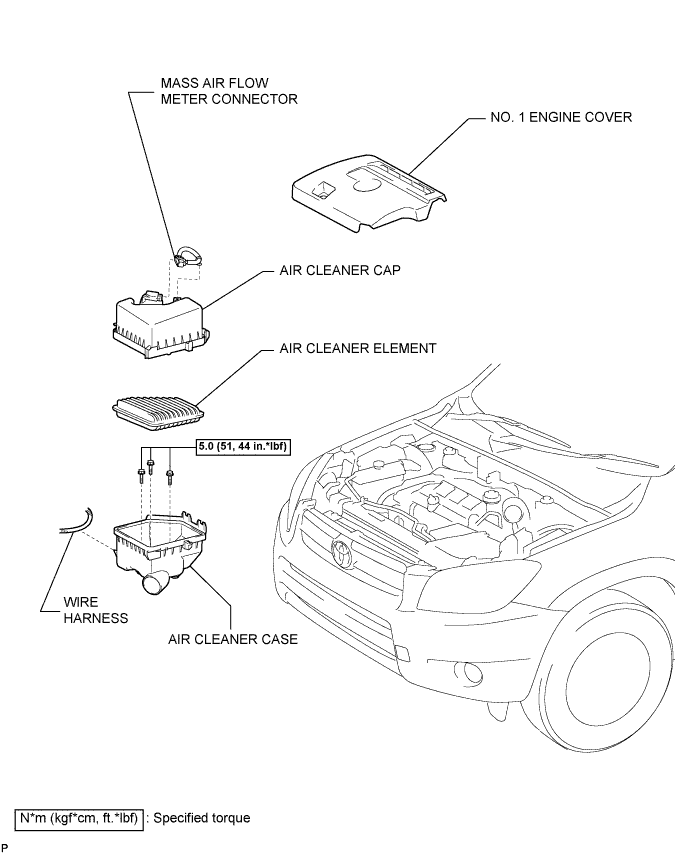

Engine coolant temperature sensor 2AD-FHV
Removal
CAUTION:
Wait at least 90 seconds after disconnecting the cable from the negative (-) battery terminal to prevent airbag and seat belt pretensioner activation.
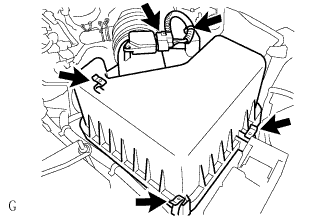
-
Disconnect the mass air flow meter connector.
-
Disconnect the wire harness clamp.
-
Unhook the 3 hook clamps, and then remove the air cleaner cap.
-
Remove the air cleaner filter element from the air cleaner case.
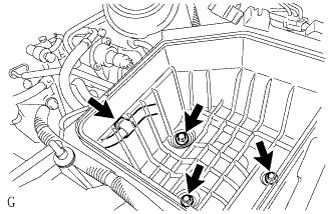
-
Disconnect the wire harness clamp and remove the 3 bolts and air cleaner case.
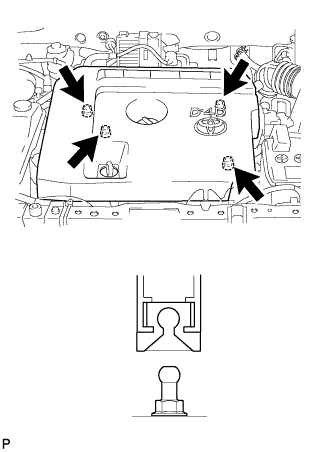
-
Detach the 4 clips and remove the engine cover.
-
Loosen the radiator drain cock plug.
HINT:
Collect the coolant in a container and dispose of it according to the regulations in your area.
-
Remove the radiator reservoir cap.
CAUTION:
Do not remove the radiator reservoir cap while the engine and radiator are still hot. Pressurized, hot engine coolant and steam may be released and cause serious burns.
-
Loosen the cylinder block drain cock plug.
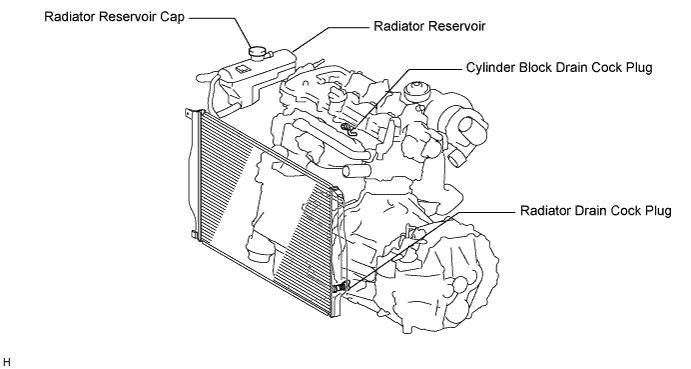

-
Disconnect the sensor connector.
-
Remove the sensor and gasket.
Engine coolant temperature sensor 2AD-FHV
Inspection
-
Partially soak the sensor in water and warm up the water.

-
Measure the resistance between the terminals.
Standard resistance:
Temperature Specified Condition Approx. 20°C (68°F) 2.32 to 2.59 k? Approx. 80°C (176°F) 0.310 to 0.326 k? NOTICE:
While checking the engine coolant temperature sensor in water, be careful not to allow water to enter the terminals. After checking, wipe off any water on the engine coolant temperature sensor.
If the result is not as specified, replace the sensor.
Engine coolant temperature sensor 2AD-FHV
Installation

-
Install a new gasket to the sensor.
-
Install the sensor.
Torque:
20 Н*м{ 200 кгс*см , 14 фунт-сила-футов }
-
Connect the sensor connector.
-
Tighten the radiator drain cock plug by hand.
-
Tighten the cylinder block drain cock plug.
Torque:
12.7 Н*м{ 130 кгс*см , 10 фунт-сила-футов }
-
Add TOYOTA Super Long Life Coolant (SLLC) to the radiator reservoir filler opening.

-
Continue adding TOYOTA SLLC until it is filled to the B line.
HINT:
The B line is the lower edge of the inner wall of the filler neck.
Standard capacity:
Item Specified Condition w/o Combustion Type Power Heater 7.3 liters (7.7 US qts, 6.4 Imp. qts) w/ Combustion Type Power Heater 7.7 liters (8.1 US qts, 6.8 Imp. qts) HINT:
TOYOTA vehicles are filled with TOYOTA SLLC at the factory. In order to avoid damage to the engine cooling system and other technical problems, only use TOYOTA SLLC or similar high quality ethylene glycol based non-silicate, non-amine, non-nitrite, non-borate coolant with long-life hybrid organic acid technology (coolant with long-life hybrid organic acid technology consists of a combination of low phosphates and organic acids).
NOTICE:
Never use water as a substitute for engine coolant.
-
Press the inlet and outlet radiator hoses several times by hand, and then check the level of the coolant. If the coolant level drops below the B line, add TOYOTA SLLC to the B line.
-
Install the radiator reservoir cap.
-
Start the engine, and warm it up until the cooling fan operates.
-
Set the air conditioning as follows while warming up the engine.
Item Specified Condition Manual Air Conditioning System Fan speed - Any setting except "OFF" Temperature - Toward WARM Air conditioning switch "OFF" Automatic Air Conditioning System Temperature - Toward MAX Air conditioning switch "OFF" -
Maintain the engine speed at 2,000 to 2,500 rpm and warm up the engine until the cooling fan operates.
NOTICE:
- Make sure that the radiator reservoir still has some coolant in it.
- Pay attention to the needle of the water temperature meter. Make sure that the needle does not show an abnormally high temperature.
- If there is not enough coolant, the engine may burn out or overheat.
- Immediately after starting the engine, if the radiator reservoir does not have any coolant, perform the following: 1) stop the engine, 2) wait until the coolant has cooled down, and 3) add coolant until the coolant is filled to the B line.
- Until the coolant level has stabilized, run the engine at 2,000 rpm.
-
-
Press the inlet and outlet radiator hoses several times by hand to bleed air.
CAUTION:
When pressing the radiator hoses:
- Wear protective gloves.
- Be careful as the radiator hoses are hot.
- Keep your hands away from the radiator fan.
-
Stop the engine and wait until the coolant cools down to ambient temperature.

-
Check that the coolant level is between the FULL and LOW line. If the coolant level is below the LOW line, repeat all of the procedures above. If the coolant level is above the FULL line, drain coolant so that the coolant level is between the FULL and LOW line.

-
Install the cleaner case with the 3 bolts and connect the wire harness clamp.
Torque:
5.0 Н*м{ 51 кгс*см , 44 фунт-сила-дюймов }
-
Install the air filter element.

-
Insert the hinge parts of the air cleaner cap into the air cleaner case, and then hang the 3 hook clamps.
-
Connect the mass air flow meter connector.
-
Engage the wire harness clamp.
-
Remove the radiator reservoir cap.
CAUTION:
To avoid the danger of being burned, do not remove the radiator reservoir cap while the engine and radiator are still hot. Thermal expansion will cause hot engine coolant and steam to blow out from the radiator.
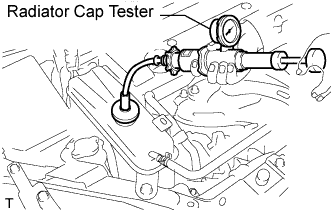
-
Fill the radiator with coolant, and then attach a radiator cap tester.
-
Warm up the engine.
-
Pump the radiator cap tester to 137 kPa (1.4 kgf/cm2, 19 psi), and then check that the pressure does not drop. If the pressure drops, check the hoses, radiator and water pump for leakage. If there are no signs of external coolant leaks, check the heater core, cylinder block and head.
-
Reinstall the radiator cap.